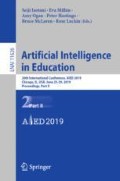Abstract
Introducing computational modeling into STEM classrooms can provide opportunities for the simultaneous learning of computational thinking (CT) and STEM. This paper describes the C2STEM modeling environment for learning physics, and the processes students can apply to their learning and modeling tasks. We use an unsupervised learning method to characterize student learning behaviors and how these behaviors relate to learning gains in STEM and CT.
Access this chapter
Tax calculation will be finalised at checkout
Purchases are for personal use only
References
Basu, S., Biswas, G., Kinnebrew, J.S.: Learner modeling for adaptive scaffolding in a computational thinking-based science learning environment. User Model. User-Adap. Inter. 27(1), 5–53 (2017)
Basu, S., McElhaney, K., Grover, S., Harris, C., Biswas, G.: A principled approach to designing assessments that integrate science and computational thinking. In: Proceedings of ICLS 2018 (2018)
Basu, S., Dickes, A., Kinnebrew, J.S., Sengupta, P., Biswas, G.: CTSiM: A computational thinking environment for learning science through simulation and modeling. In: Conference on Computer Supported Education, pp. 369–378, Germany (2013)
Berland, M., Martin, T., Benton, T., Smith, C.P., Davis, D.: Using learning analytics to understand the learning pathways of novice programmers. J. Learn. Sci. 22(4), 564–599 (2013)
Blikstein, P., Worsley, M., Piech, C., Sahami, M., Cooper, S., Koller, D.: Programming pluralism: using learning analytics to detect patterns in the learning of computer programming. J. Learn. Sci. 23(4), 561–599 (2014)
Grover, S., Jackiw, N., Lundh, P.: Concepts before coding: non-programming interactives to advance learning of introductory programming concepts in middle school. Comput. Sci. Educ. (2019). https://doi.org/10.1080/08993408.2019.1568955
Hestenes, D., Wells, M., Swackhamer, G.: Force concept inventory. Phys. Teach. 30(3), 141–158 (1992)
Hutchins, N., Biswas, G., Maroti, M., Broll, B., Ledezci, A.: C2STEM: a design-based approach to a classroom-centered OELE. In: Proceedings of AIED 2018 (2018)
Johnson, S.C.: Hierarchical clustering schemes. Psychometrika 32(3), 241–254 (1967)
Jona, K., Wilensky, U., Trouille, L., Horn, M. S., Orton, K., Weintrop, D., Beheshti, E.: Embedding computational thinking in science, technology, engineering, and math (CT-STEM). In: Future Directions in Computer Science Education Summit Meeting, Orlando, FL (2014)
Jonassen, D., Strobel, J., Gottdenker, J.: Model building for conceptual change. Interact. Learn. Environ. 13(1–2), 15–37 (2005)
NGSS Lead States: Next Generation Science Standards: For states, by states. National Academies Press, Washington, DC (2013)
Piech, C., Huang, J., Nguyen, A., Phulsuksombati, M., Sahami, M., Guibas, L.: Learning program embeddings to propagate feedback on student code. In: Proceedings of the 32nd International Conference on Machine Learning, Lille, France pp. 1093–1102 (2015)
Sengupta, P., Dickes, A., Farris, A.V., Karan, A., Martin, D., Wright, M.: Programming in K-12 science classrooms. Commun. ACM 58(11), 33–35 (2015)
Sengupta, P., Farris, A.V., Wright, M.: From agents to continuous change via aesthetics: learning mechanics with visual agent-based computational modeling. Technol. Knowl. Learn. 17(1–2), 23–42 (2012)
Sengupta, P., Kinnebrew, J.S., Basu, S., Biswas, G., Clark, D.: Integrating computational thinking with K-12 science education using agent-based computation: a theoretical framework. Educ. Inf. Technol. 18(2), 351–380 (2013)
Shen, J., Lei, J., Chang, H.-Y., Namdar, B.: Technology-enhanced, modeling-based instruction (TMBI) in science education. In: Spector, J.M., Merrill, M.D., Elen, J., Bishop, M.J. (eds.) Handbook of Research on Educational Communications and Technology, pp. 529–540. Springer, New York (2014). https://doi.org/10.1007/978-1-4614-3185-5_41
Weintrop, D., et al.: Defining computational thinking for mathematics and science classrooms. J. Sci. Educ. Technol. 25(1), 127–147 (2016)
Werner, L., McDowell, C., Denner, J.: A first step in learning analytics: pre-processing low-level Alice logging data of middle school students. J. Educ. Data Min. 5(2), 11–37 (2013)
Acknowledgments
We thank Marian Rushdy, Naveed Mohammed, and our other collaborators at Vanderbilt University, Stanford University, Salem State University, SRI International, and ETS. This research is supported by NSF grant #1640199.
Author information
Authors and Affiliations
Corresponding author
Editor information
Editors and Affiliations
Rights and permissions
Copyright information
© 2019 Springer Nature Switzerland AG
About this paper
Cite this paper
Hutchins, N., Biswas, G., Grover, S., Basu, S., Snyder, C. (2019). A Systematic Approach for Analyzing Students’ Computational Modeling Processes in C2STEM. In: Isotani, S., Millán, E., Ogan, A., Hastings, P., McLaren, B., Luckin, R. (eds) Artificial Intelligence in Education. AIED 2019. Lecture Notes in Computer Science(), vol 11626. Springer, Cham. https://doi.org/10.1007/978-3-030-23207-8_22
Download citation
DOI: https://doi.org/10.1007/978-3-030-23207-8_22
Published:
Publisher Name: Springer, Cham
Print ISBN: 978-3-030-23206-1
Online ISBN: 978-3-030-23207-8
eBook Packages: Computer ScienceComputer Science (R0)

